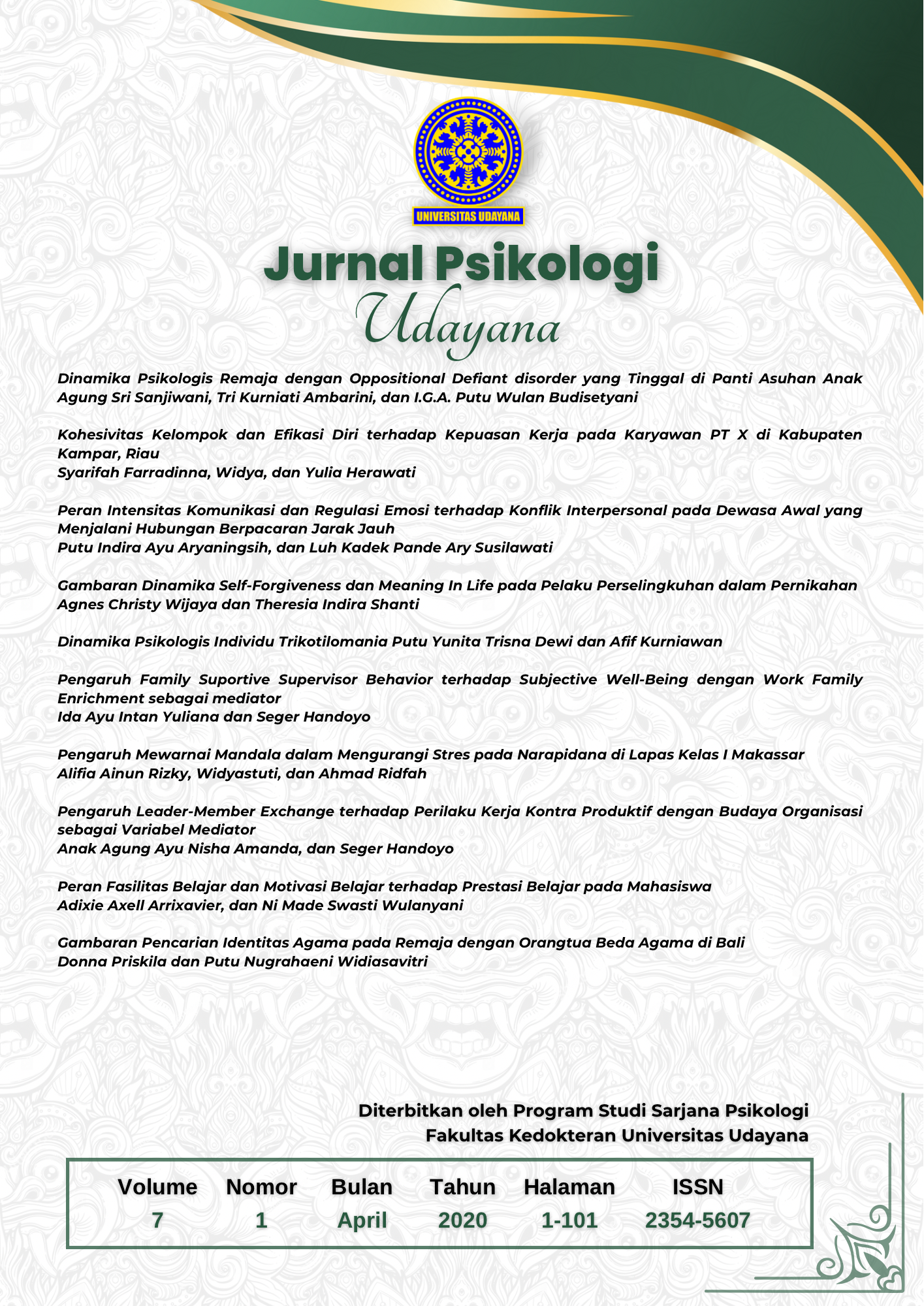Peran intensitas komunikasi dan regulasi emosi terhadap konflik interpersonal pada dewasa awal yang menjalani hubungan berpacaran jarak jauh
Abstract
Courtship is a relationship that involves a greater and deeper intimacy and romantic feelings between two individuals who know each other. During the process, courtship cannot always be done closely due to education and careers in different areas that causes long distance relationship. The distance becomes an obstacle which triggers several conflicts. The situation of conflict always involves the communication process and emotional aspects. The influent communication tends to cause misunderstanding that lead to conflict. Uncontrolled emotion causes a dangerous conflict. This study applied quantitative method that discussed the role of communication intensity and emotion regulation toward interpersonal conflict at early adulthood undergoing long distance relationships. The subjects of study involved 307 adults who had long distance relationships. In this study, the scale of interpersonal conflict, communication intensity, and emotional regulation were applied as measuring instruments. Multiple regression technique was use to do data analysis. The results of multiple regression tests showed that a regression coefficient was 0,596; a coefficient value of determination was 0,355; and a significance value was 0,000 (p<0,05) with a standardized beta coefficient on the variable of communication intensity about -0,373 and emotion regulation about -0,348. These results indicate that communication intensity and emotion regulation take a role to decrease interpersonal conflict at early adulthood who have long distance relationships.
Downloads
References
Chatterjee, A., & Kulakli, A. (2015). A study on the impact of communication system on interpersonal conflict. Procedia – Social and Behavioral Science, 320-329.
Costa, J., Jung, M. F., Czerwinski, M., Guimbretiere, F., Le, T., & Choudhury, T. (2018). Regulating feelings during interpersonal conflicts by changing voice self-perception. CHI 2018, April 21-26, 2018, Montral, QC, Canada.
Curseu, P. L., Boros, S., & Oerlemans, L. A. G. (2012). Task and relationship conflict in short-term and long-term groups: The critical role of emotion regulation. International Journal of Conflict Management, 23(1), 97-107.
Dansie, L. (2012). Long-distance dating relationships among college students: the benefits and drawbacks of using technology. (Thesis tidak dipublikasikan). University of Missouri.
DeVito, J. A. (2009). Interpersonal communication. New York: Harper Collins College Publisher.
Dunbar, R. I. M., & Machin, A. J. (2014). Sex differences in relationship conflict and reconciliation. Journal of Evolutionary Psychology.
Ferres, M. A., Segura, I. V., & Exposito, F. (2019). Couple conflict-facing responses from a gender perspective: Emotional intellegence as a differential pattern. Psychosocial Intervention, 28, 147-156.
Firmin, M. W., Firmin, R. L., & Merical, K. L. (2013). Extended communication efforts involved with college long-distance relationships. Contemporary Issues in Education Research, 6(1).
Florsheim, P. (2003). Adolescent romantic relations and sexual behavior:theory, research, and practical implications. London: Lawrence Erlbaum Associates, Publishers.
Ghozali, I. (2018). Aplikasi analisis multivariate dengan program ibm spss 25, edisi 9. Semarang: Badan Penerbit Universitas Diponegoro.
Gross, J. J. (2007). Handbook of emotion regulation. New York: The Guilford Press.
Hoeksema, N., & Aldao, A. (2011). Gender and age differences in emotion regulation strategies and their relationship to depressive symptoms. Personality and Individual Differences, 51(6).
Hurlock, E. B. (2004). Psikologi perkembangan suatu pendekatan sepanjang rentang kehidupan, edisi kelimat. Jakarta: Erlangga.
Kusuma, K. J., & Puspitadewi, N. W. S. (2018). Regulasi emosi pada individu dewasa awal yang menjalani hubungan pacaran jarak jauh. Jurnal Penelitian Psikologi, 5(2).
Lee, S. K., Bassick, M. A., & Mumpower, S. W. (2016). Fighting electronically: Long-distance romantic couples’ conflict management over mediated communication. The Electronic Journal of Communication.
Lindner, E. G. (2006). Emotion and Conflict: Why it is Important to Understand How Emotions Affect Conflict and How Conflict Affects Emotions. In Deutsch, Morton, Coleman, Peter T., and Marcus, Eric C (Eds.), The Handbook of Conflict Resolution: Theory and Practice. Secon Edition. Chapter Twelve, pp 268-293. San Fransisco, CA: Jossey-Bass.
Lokasari, P. V., Nugroho, W. B., & Zuryani, N. (2019). Komunikasi antarpribadi pasangan yang menjalani hubungan jarak jauh (long distance relationship) di Kota Denpasar. Jurnal Ilmiah Sosiologi (SOROT), 1(2).
Lopes, P. N., Nezlek, J. B., Extremera, N., Hertel, J., Berrocal, P. F., Schutz, A., & Salovey, P. (2011). Emotion regulation and the quality of social interaction: Does the ability to evaluate emotional situation and identify effective responses matter? Journal of Personality, 79(2), 429-467.
Madsen, S., & Collins, W.(2018). Personal Relationship in Adolescence and Early Adulthood. In A. Vangelisti & D. Perlman (Eds.), The Cambrigde Handbook of Personal Relationship (Cambridge Handbooks in Psychology, pp. 135-147). Cambridge: Cambridge University Press.
Maguire, K.C., & Kinney, T. A. (2010). When distance is problematic: Communication, coping, and relational satisfaction in female college students’ long-distance relationships. Journal of Applied Communication Research, 24-76.
Masumoto, K., Taishi, N., & Shiozaki, M. (2016) age and gender differences in relationships among emotion regulation, mood, and mental health. Gerontology and Geriatric Medicine, 2.
Maulana, H., & Gumelar, G. (2013). Psikologi komunikasi dan persuasi. Jakarta: Akademia Permata.
Nisa, S., & Sedjo, P. (2010). Konflik pacaran jarak jauh pada individu dewasa muda. Jurnal Psikologi, 3(2).
Pistole, M., Roberts, A., & Chapman, M. L. (2010). Attachment, relationship maintenance, and stress in long distance and geographically close romantic relationships. Journal of Social and Personal Relationship, 27, 535-553.
Pratiwi, N. N. A. Y., & Lestari, M. D. (2017). Perbedaan kualitas komunikasi antara individu dewasa awal yang berpacaran jarak jauh dan jarak dekat di Denpasar. Jurnal Psikologi Udayana, 4(1).
Putri, R. J. (2016). Komunikasi antar pribadi untuk pengelolaan konflik tuduhan tak berdasar pada passangan Long-Distance Relationship. (Skripsi tidak dipublikasikan). Fakultas Ilmu Sosial dan Ilmu Politik, Universitas Diponegoro, Semarang.
Ratnasari, S., & Suleeman, J. (2017). Perbedaan regulasi emosi perempuan dan laki-laki di perguruan tinggi. Jurnal Psikologi Sosial, 15(1).
Robbins, S. P., & Judge, T. A. (2009). Organizational behavior 13th edition. New Jersey: Pearson Education.
Sahlstein, E. M. (2006). Making plans: Praxis strategies for negotiating uncertainty-certainty in long-distance relationships. Western Journal of Communication, 70.
Santoso, S. (2016). Panduan lengkap spss versi 23. Jakarta: PT Elex Media Komputindo.
Santrock, J. W. (2003). Adolescence: perkembangan remaja. Jakarta: Erlangga.
Schoeder-Abe, M., & Schutz, A. (2011). Walking in each other’s shoes: Perspective taking mediates effects of emotion intellegence on relationship quality. Journal of Personality, 25.
Stafford, K. A. (2005). On the nature and function of emotion: A component process approach. Dalam R. Scherer & P. E. Ekman (Eds). Approaches to Emotion. Hal 293-317. Hillsdale, NJ: Erlbaum.
Sudijono. (2012). Pengantar statistika pendidikan. Jakarta: PT Raja Grafindo Persada.
Sugiyono. (2016). Metode penelitian kuantitatif, kualitatif dan kombinasi (mx methods). Bandung: Alfabeta.
The Center for Study of Long Distance Relationship. (2015). Do LDRs work? Do Long Distance Relationship work? Diunduh dari http://www.longdistancerelationships.net.htm#Do_LDRs_work_Dolong_distance_relationship_work 25 April 2019.
Trives, J. J. R., Bravo, B. N., Postigo, J. M. L., Segura, L. R., & Watkins, E. (2016). Age and gender differences in emotion regulation strategies: Autobiographical memory, rumination, problem solving, and distraction. The Spanish Journal of Psychology, 19.
Wibisono, N. (2016). Menerabas jarak demi cinta. Diunduh dari tirto.id/menerabas-jarak-demi-cinta-bw5f 25 April 2019.
Widiantari, K. S., & Herdiyanto, Y. K. (2013). Perbedaan intensitas komunikasi melalui jejaring sosial antara tipe kepribadian ekstrovert dan introvert pada remaja. Jurnal Psikologi Udayana, 2013, 1(1).
Wilmot, W. W., & Hocker, J. L. (2007). Interpersonal conflict 7th edition. New York: McGraw-Hill.

This work is licensed under a Creative Commons Attribution-ShareAlike 4.0 International License.
Authors who publish with this journal agree to the following terms:
- Authors retain copyright and grant the journal right of first publication with the work simultaneously licensed under a Creative Commons Attribution-ShareAlike 4.0 International License that allows others to share the work with an acknowledgement of the works authorship and initial publication in this journal.
- Authors are able to enter into separate, additional contractual arrangements for the non-exclusive distribution of the journals published version of the work (e.g., post it to an institutional repository or publish it in a book), with an acknowledgement of its initial publication in this journal.
- Authors are permitted and encouraged to post their work online (e.g., in institutional repositories or on their website) prior to and during the submission process, as it can lead to productive exchanges, as well as earlier and greater citation of published work (See The Effect of Open Access).













